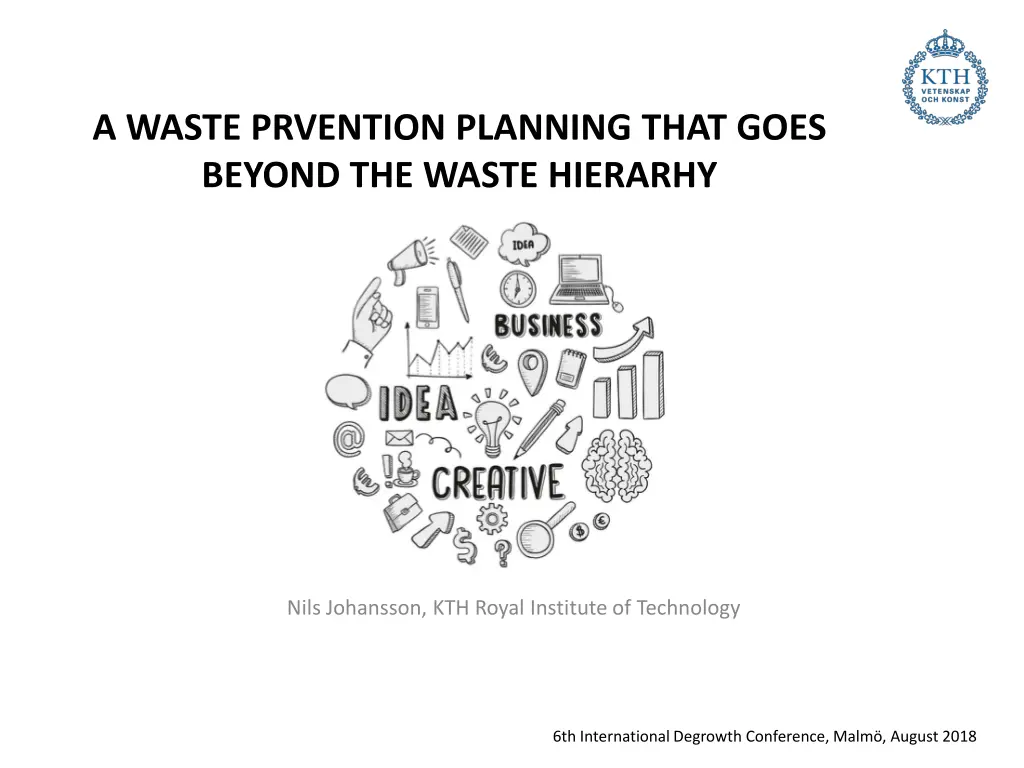
Strategies for Effective Waste Prevention Planning and Implementation
Explore the challenges and shortcomings of waste prevention policies, focusing on strategies that go beyond the waste hierarchy. Discover key insights into why policies have failed to prevent waste effectively and how to address the drivers of waste generation. Learn about waste prevention plans at European, national, and local levels, emphasizing the need for specific targets and measures to ensure success.
Download Presentation

Please find below an Image/Link to download the presentation.
The content on the website is provided AS IS for your information and personal use only. It may not be sold, licensed, or shared on other websites without obtaining consent from the author. If you encounter any issues during the download, it is possible that the publisher has removed the file from their server.
You are allowed to download the files provided on this website for personal or commercial use, subject to the condition that they are used lawfully. All files are the property of their respective owners.
The content on the website is provided AS IS for your information and personal use only. It may not be sold, licensed, or shared on other websites without obtaining consent from the author.
E N D
Presentation Transcript
A WASTE PRVENTION PLANNING THAT GOES BEYOND THE WASTE HIERARHY Nils Johansson, KTH Royal Institute of Technology 6th International Degrowth Conference, Malm , August 2018
WASTE PREVENTION SHALL BE PRIORITY 1. PREVENT 2. REUSE 3. RECYCLE 4. RECOVER 5. LANDFILL European Directives (1975;2008) Environment Action Program (1977) Environmental Quality Objectives (1999)
THE WASTE GENERATION IS INCREASING Municipal waste generation (Swe) 500 450 400 kg/capita 350 300 1995 2000 2005 2010 2015 2017 Year
METHOD Waste prevention plans: European level; National level and local level. All objectives and measures were coded
THE PLANS FOCUS ON THE MANAGEMENT OF WASTE Reuse leads only to waste prevention under strict conditions, and could often trigger more consumption rather then less.
SOFT POLICIES Only 1 out of 26 objectives has a specified target to prevent waste, encompassing external actors. Household waste shall decrease by 10% (G vle, 2016: 17).
Typical measures for waste prevention are to examine, facilitate, promote, inform and coordinate Neither incentives nor consequences are connected to the measures
IGNORING THE DRIVERS FOR WASTE GENERATION Limited focus on consumption, the driver of waste generation Focus instead on breaking the link between consumption (cause) and waste generation (effect)
FOCUS ON SMALL WASTE STREAMS Most attention given to waste common in households, and especially food waste. Food waste is a residue, which mean that it can be prevented without effecting consumption or production of food.
MARKET BASED POLICIES The responsibility for waste prevention is handed over from policy makers to the market. Many citizen-driven projects have been promoted by the authorities But the control becomes weaker, and the total effect uncertain
CONCLUSIONS A new softness to policies in the waste sector In some cases, soft policies are normal in new sectors, to later developed into hard policies. More focus upstream on consumption and production Regulate through environmental permits or promote initiatives with a high effect
TOWARD A NEW WASTE GOVERNANCE WASTE HIERARCHY WASTE GOVERNANCE 1. PREVENT 1. REUSE 2. COLLECT 2. RECYCLE 3. MANAGE 3. RECOVER 4. LANDFILL



